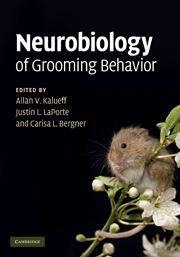Book contents
- Frontmatter
- Contents
- List of contributors
- Preface
- 1 Grooming, sequencing, and beyond: how it all began
- 2 Self-grooming as a form of olfactory communication in meadow voles and prairie voles (Microtus spp.)
- 3 Phenotyping and genetics of rodent grooming and barbering: utility for experimental neuroscience research
- 4 Social play, social grooming, and the regulation of social relationships
- 5 Grooming syntax as a sensitive measure of the effects of subchronic PCP treatment in rats
- 6 Modulatory effects of estrogens on grooming and related behaviors
- 7 Lack of barbering behavior in the phospholipase Cβ1 mutant mouse: a model animal for schizophrenia
- 8 Grooming after cerebellar, basal ganglia, and neocortical lesions
- 9 Striatal implementation of action sequences and more: grooming chains, inhibitory gating, and the relative reward effect
- 10 An ethological analysis of barbering behavior
- 11 Should there be a category: “grooming disorders?”
- 12 Neurobiology of trichotillomania
- Index
- References
2 - Self-grooming as a form of olfactory communication in meadow voles and prairie voles (Microtus spp.)
Published online by Cambridge University Press: 04 August 2010
- Frontmatter
- Contents
- List of contributors
- Preface
- 1 Grooming, sequencing, and beyond: how it all began
- 2 Self-grooming as a form of olfactory communication in meadow voles and prairie voles (Microtus spp.)
- 3 Phenotyping and genetics of rodent grooming and barbering: utility for experimental neuroscience research
- 4 Social play, social grooming, and the regulation of social relationships
- 5 Grooming syntax as a sensitive measure of the effects of subchronic PCP treatment in rats
- 6 Modulatory effects of estrogens on grooming and related behaviors
- 7 Lack of barbering behavior in the phospholipase Cβ1 mutant mouse: a model animal for schizophrenia
- 8 Grooming after cerebellar, basal ganglia, and neocortical lesions
- 9 Striatal implementation of action sequences and more: grooming chains, inhibitory gating, and the relative reward effect
- 10 An ethological analysis of barbering behavior
- 11 Should there be a category: “grooming disorders?”
- 12 Neurobiology of trichotillomania
- Index
- References
Summary
Summary
We explore the possibility that self-grooming in response to the odors or presence of another animal plays a role in olfactory communication. For some animals, the substances released by self-grooming may make groomers more easily detected, more attractive, and/or less threatening to conspecifics that are in close proximity to them. The fact that animals self-groom at different rates when they encounter different individuals suggests that they can target particular conspecifics for purposes of communicating with them. Given that voles and other animals generally spend more time grooming in response to reproductively active, opposite-sex conspecifics than to reproductively quiescent opposite-sex conspecifics, self-grooming may be involved in attracting potential mates and is associated with the behaviors that surround reproduction. Studies have shown that conditions such as endocrine state, diet, age, and familiarity and relatedness of both the groomer and the scent donor affect the amount of time that individuals self-groom when they are exposed to the odors of opposite-sex conspecifics. Consequently, self-grooming in response to the odors of opposite-sex conspecifics may be akin to scent marking in that animals are transmitting odiferous substances into the environment that honestly signal features of their quality and condition to potential mates and competitors.
Introduction
As many terrestrial animals move about their home ranges they are surrounded by scent marks, some are their own and some are those of conspecifics. Animals investigating these scent marks can often determine many features about the individual that deposited them such as its sex, age, reproductive condition, diet, etc.
- Type
- Chapter
- Information
- Neurobiology of Grooming Behavior , pp. 19 - 45Publisher: Cambridge University PressPrint publication year: 2010
References
- 1
- Cited by



